Naval Battle of Vella Lavella: BAA BAA BLACK SHEEP SQUADRON
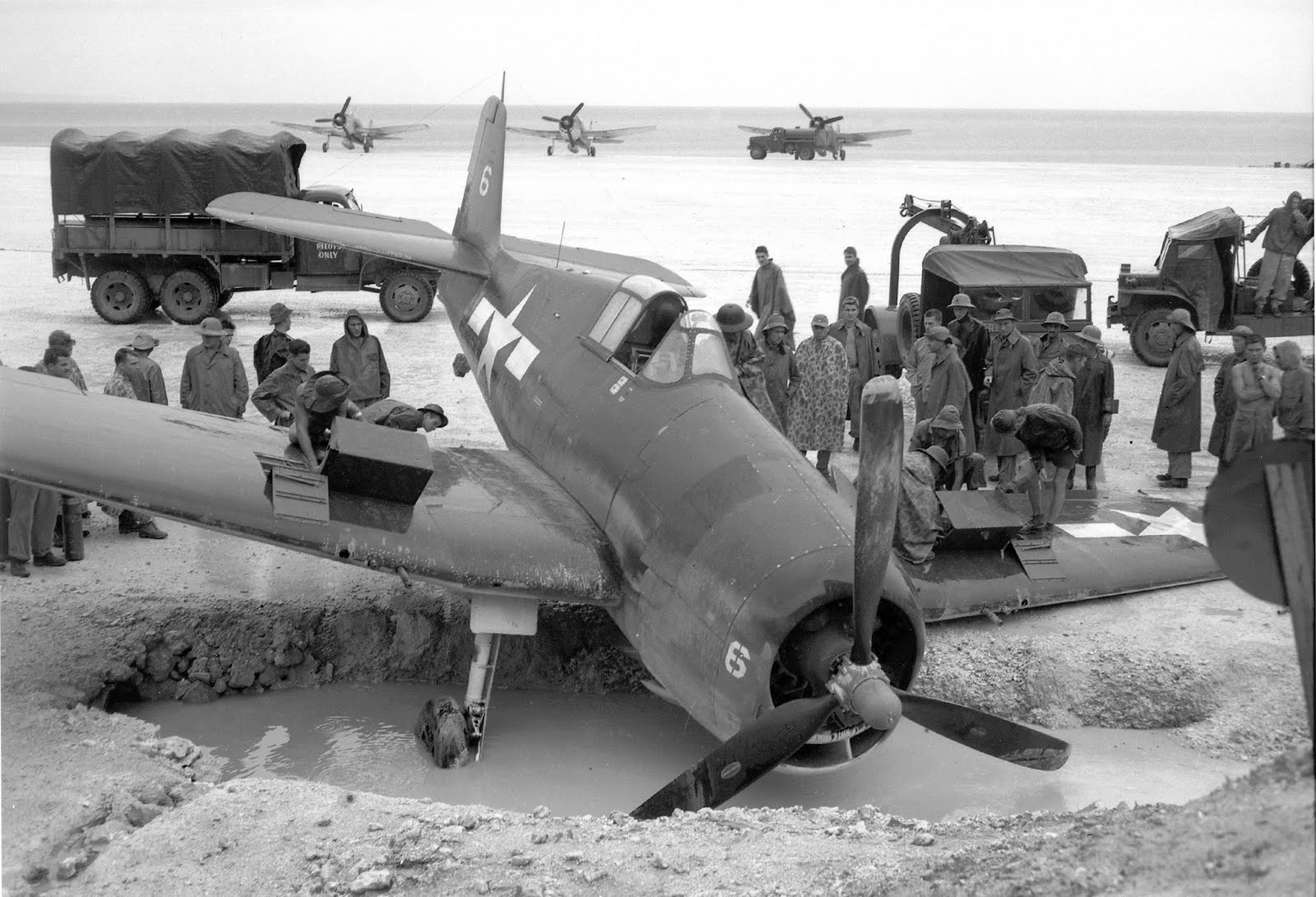 |
|
Barakoma airstrip, on Vella LaVella Island Established in September 1943, VF-33 were first equipped with the Grumman F6F "Hellcat". Their first operation was to the Soloman islands, the first time a US Navy squadron has used the F6F in combat. VF-33 was land based at this time, supporting the island hopping Pacific campaign. VF-33 disestablished in July 1946. F6F Hellcat fighters were designed with additional features such as heavy armor and self-sealing fuel tanks that were installed to provide additional safety to their pilots. With its six .50 caliber Browning M2 machine guns, it could unleash a hail of bullets that all adversaries feared. By the end of WWII, F6F's participated in nearly every engagement in the Pacific theater since their introduction in 1943 and achieved a kill:loss ratio of 19:1. Repeated overwhelming victories demonstrated that the United States had finally produced a fighter that not only matched but exceeded the feared Japanese Zero.
Vella Lavella is an island in the Western Province of the Solomon Islands. It lies to the west of New Georgia, but is considered one of the New Georgia Group. To its west is the Treasury Islands. Vella Lavella Island was seized in the summer of 1943 and served as a base of operations to support landings by Allied forces in the Treasury Islands and at Cape Torokina, Bougainville. The swift advance of Allied forces in the South Pacific soon bypassed Vella Lavella and the airfield ceased operations in September 1944, less than a year after the first aircraft arrived.
The sea around the island was the site of the Naval Battle of Vella Lavella in World War II. The Land Battle of Vella Lavella took place from 15 August to 9 October 1943. During World War II, Vella Lavella was the home base for VMF-214, the "Black Sheep," led by Gregory "Pappy" Boyington.  USS Coral Sea: Corsairs and Spads standing by to launch
Seabees of the 58th Naval Construction Battalion began landing on 15 August and set to work unloading the landing ships under frequent air attack. Among the first items unloaded were bulldozers, which were used to construct roads inland to sites where supplies could be dumped, dispersed away from the beach and each other. The Seebees built 9 miles (14 km) of roads during August. Their next task was the construction of a dispensary and an underground sick bay. An underground radio room was also built. The 4,000-by-200-foot (1,219 by 61 m) airstrip was surveyed and cleared during August, followed by the construction of the signal tower, operations room, avgas storage tanks and an accommodation camp for personnel in September. The first landing was made on the airstrip of 24 September. Work continued on developing the airbase into December, including the provision of an avgas tank farm with six 1,000-US-barrel (120,000 l; 31,000 US gal; 26,000 imp gal) tanks.[31] Vella Lavella became an important Allied airbase from which they were able to project air power towards Rabaul. It was the home base of Major Gregory Boyington's VMF-214, and other units.
The channel through the reef was deepened to allow the passage of PT boats into the lagoon.[31] PT Squadron 11 established a base on the northeast coast of Vella Lavella on 25 September with seven PT boats and a small coastal transport (APc).[33] A ramp was built for LSTs, and the jetty at Biloa was upgraded with the addition of an L-shaped end. This was subsequently improved by raising the surface, deepening the water, and adding pilings and ship camels. The 77th Naval Construction Battalion arrived on 25 September, in the midst of a Japanese air raid. During its tour on Vella Lavella, it would be bombed 47 times, and suffer ten casualties. Its main task was the construction of hospital facilities with 1,000 beds for the upcoming Bougainville campaign. This included wards, operating rooms and administrative buildings. The 58th Naval Construction Battalion established a sawmill that produced 5,000 to 6,000 board feet (12 to 14 m3) of cut lumber per day. The 77th Naval Construction Battalion operated two more to satisfy the demands of the campaigns in the Treasury Islands and Bougainville. A detachment of the 53rd Naval Construction Battalion operated two more sawmill between November 1943 and January 1944.
August 3, 1942: After hammering Port Moresby for two days, Japanese bombers finally sank this Australian transport which sends up a cloud of smoke. She drifted onto a reef and heeled over. Flaming oil can be seen at left. The men in a small boat, foreground, are looking for victims.November 2, 1943: A B-25 bomber of the U.S. Army 5th Air Force strikes against a Japanese ship in the harbor at Rabaul, New Britain during an air raid on the Japanese-held air and naval base. Nov. 11, 1943: Crewmen of a U.S. Coast Guard combat transport go for a swim under the hull of a Japanese landmark in the Solomon Islands during World War II. The boat is the Kinugawa Maru, beached by the Japanese after being riddled by American gunners. Coast guardsmen took part in the original invasion of the Solomons.
Two New Zealand field engineer co
A wounded marine receives treatment from a Navy medical corpsman at a jungle first aid station behind the lines on New Britain Island, New Guinea, in the Battle for the Strategic Japanese air field on Cape Gloucester during World War II. mpanies (the 20th and 26th) were also sent to the island following the commitment of New Zealand troops. These worked alongside the Americans to improve roads and constructed several bridges.[34] The last of the US naval construction battalions left Vella Lavella in January 1944, and responsibility for the installations on Vella Lavella passed to the 502nd Construction Battalion Maintenance Unit (CBMU). Salvage operations commenced in May 1944, and the airstrip was abandoned on 15 June 1944. The final task was dismantlement of the tank farm. The 502nd CBMU then departed for Emirau on 12 July 1944.
|  Naval Battle of Vella Lavella
The Battle of Vella Lavella, fought on 6 October 1943, occurred as a result of a Japanese effort to evacuate a 600-man garrison from the island of that name, in the Solomons. These men had been operating a barge base at Horaniu, on the northeast shore of Vella Lavella, since 17 August, assisting in the withdrawal of some 10,000 troops from bypassed Kolombangara. When Allied forces occupied Horaniu on 14 September, the garrison withdrew to Marquana Bay on the northwest tip of the island to await rescue by the navy.
The force assembled for the task was somewhat out-sized considering the small number of men to be evacuated; it was apparent that Rear Admiral Ijuin Matsuji, Comdesron 3 in AKIGUMO, was expecting a fight. Nine destroyers, a Support Group (AKIGUMO, ISOKAZE, KAZAGUMO, YUGUMO, SHIGURE, SAMIDARE) and a Transport Group (FUMIZUKI, MATSUKAZE, YUNAGI) left Rabaul early in the morning of the 6th and steamed south at high speed to rendezvous with a supplemental evacuation unit of some 20 barges and small craft from Buin. As they approached Vella Lavella, Captain Hara Tameichi's Desdiv 27 (SHIGURE and SAMIDARE) was detached to cover the Transport Group (and hopefully confuse the enemy as to Japanese strength) while Ijuin's four remaining destroyers swept ahead to block out any intervening forces.
And intervention was indeed en route, for Allied patrol planes had spotted Ijuin early in the afternoon and six U. S. destroyers were sent pounding north to intercept. But Captain Frank R. Walker's Northern Group (SELFRIDGE, CHEVALIER, O'BANNON) was about 20 miles ahead of Captain Harold O. Larson's Southern Group (RALPH TALBOT, TAYLOR, LAVALLETTE), and Walker chose not to wait for Larson's support before attacking. This was the first of several impetuous decisions made by the U. S. commander. Perhaps, as the late Paul Dull has written, Captain Walker had "a little bit of banzai in him, too."
Admiral Ijuin also had aerial spotters up; these reported the American forces steaming north, but exaggerated their strength as including four cruisers, an error which would color Ijuin's movements throughout the battle and help to rescue Walker from some of his own mistakes. The Japanese sighting reports led to the early withdrawal of Captain Kanaoka Yuzo's three lightly-armed destroyer-transports, leaving Desdiv 27 operating eight miles to the west of Ijuin's four ships when action was joined with Walker just after 2230, some 12 miles north-northwest of Vella Lavella.
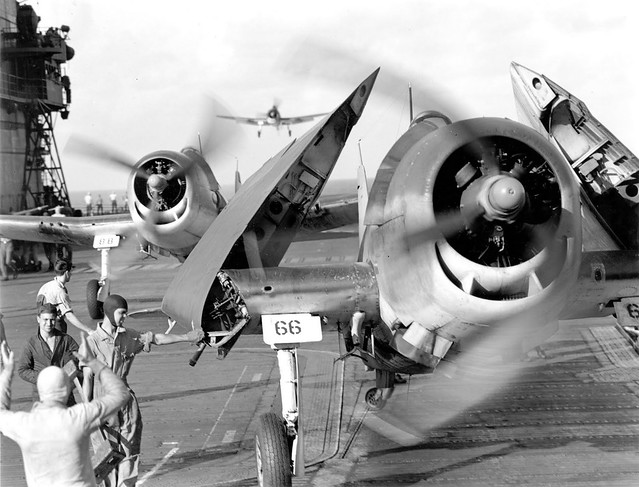 Hellcats recovering on CV-6 after raid on Tarawa Atoll
Grumman F6F-3 Hellcat fighters landing on USS Enterprise (CV-6) after strikes on the Japanese base at Truk, 17-18 February 1944. Flight deck crewmen are folding planes' wings and guiding them forward to the parking area. The original caption gives date as 16 February, 1942.
Ijuin's best opportunity came early in the action when, turning due south, he was in an excellent position to cap the onrushing Walker's "T." But the Japanese admiral almost immediately commenced a series of complex maneuvers which not only lost him this advantage, but sent his own column skidding through dangerous waters, waters into which Walker's ships at 2255 began unleashing 14 torpedoes. The American destroyers opened up with their guns 20 seconds later. Ijuin, his own ships masking each others' fire while dodging shell-splashes, seemed in a fix.
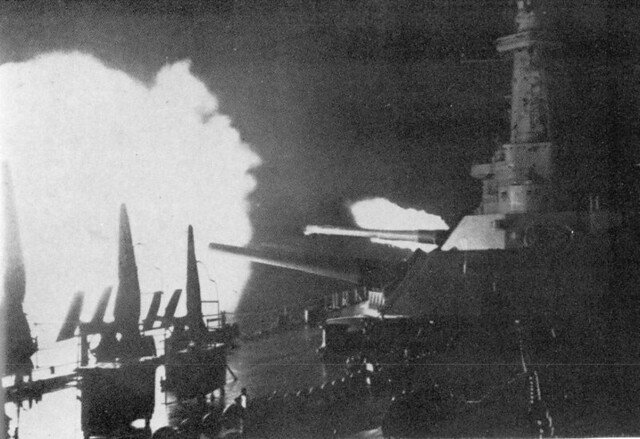 Naval Battle of Guadalcanal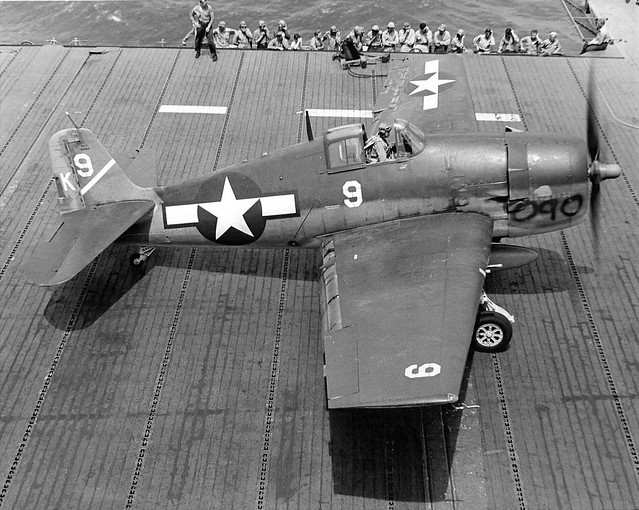 USS Yorktown (CV-10) VF-1 F6F-3 Hellcat fighter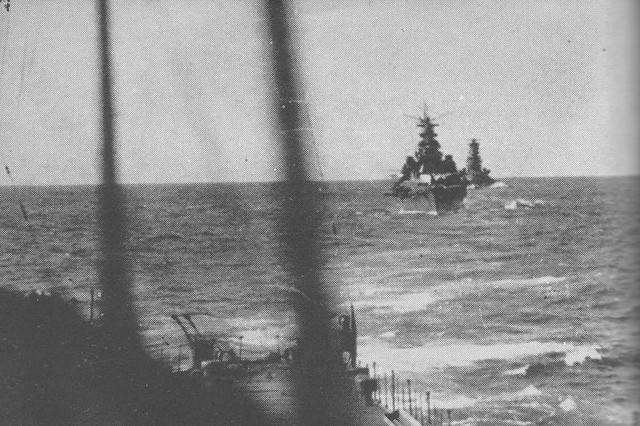 Naval Battle of Guadalcanal |
 |
At this point Commander Oosako Azuma of YUGUMO, at the rear of Ijuin's column, apparently decided to take matters into his own hands, for at 2256 YUGUMO suddenly broke formation and charged the Americans, opening gunfire and launching torpedoes as she went. The intrepid destroyer also promptly began taking hits, and was soon reduced to a battered wreck. But YUGUMO's bold attack had turned the tide of battle.
At 2301 a YUGUMO Long-Lance found CHEVALIER's forward magazine and the resulting explosion tore the destroyer's bow off as far aft as the bridge. O'BANNON, next in line, then plowed into CHEVALIER's stern, thus quickly reducing Walker's strength by two-thirds. This success was YUGUMO's last, for at 2303 the blazing destroyer took at least one American torpedo in return, blew up, and sank at 2310. Admiral Ijuin, observing YUGUMO's sacrifice from afar, disconsolately turned south and then west, making smoke to cover his withdrawal.
But Captain Walker in SELFRIDGE was not yet done: his flagship continued plunging ahead to engage SHIGURE and SAMIDARE, now steering across his front at high speed to join Ijuin. Captain Hara's destroyers got off a spread of 16 Long-Lances and at 2306 one of SAMIDARE's caught SELFRIDGE on her port side forward, bringing her to a stop and all but ending the battle.
By this time Captain Larson's three-ship division was a mere 15 minutes away from joining in the fray, but Ijuin's recon plane advised him of this fact and the admiral, not wishing to engage any more "cruisers," ordered retreat. Thus unable to find any enemy to engage, Larson set about succoring Walker's cripples. Both SELFRIDGE and O'BANNON, bows shattered, were able to limp home, but CHEVALIER was beyond salvage and LAVALLETTE scuttled her with a torpedo at 0311; all but 51 of her crew had earlier been removed. PT-boats later rescued 78 YUGUMO survivors while another 25 reached safety in an abandoned O'BANNON lifeboat. Commander Oosako was not among them.
While the above rescue operations were underway, Captain Nakayama Shigoroku's little convoy of barges and sub-chasers chugged purposefully into Marquana Bay, took on the 589 evacuees, and sailed for Buin at 0305, mission accomplished.
 USS Coral Sea (CVB-43), Skyraiders & Corsairs
Though much has been made of Ijuin's missed chances and the fact that "evacuations don't win wars," it would be both unrealistic and unchivalrous to assert that Vella Lavella was anything but a Japanese victory. Ijuin's forces knocked out three American destroyers for the loss of one of their own, and Nakagawa's vulnerable small-craft pulled off the troop evacuation without loss. Captain Walker was admittedly out-numbered, but this was only the more reason for him to have been more circumspect in his moves. He was not, and it was left for the Long-Lancers to blast out yet another chapter in their long record of night-fighting prowess.
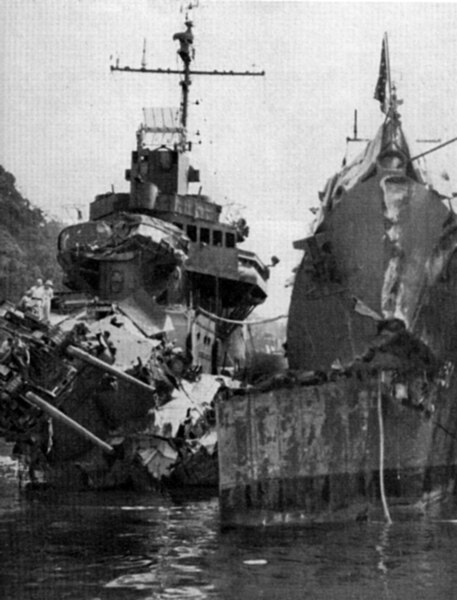 The destroyers USS Selfridge and O'Bannon at Noumea after the battle.Naval Battle of Vella Lavella 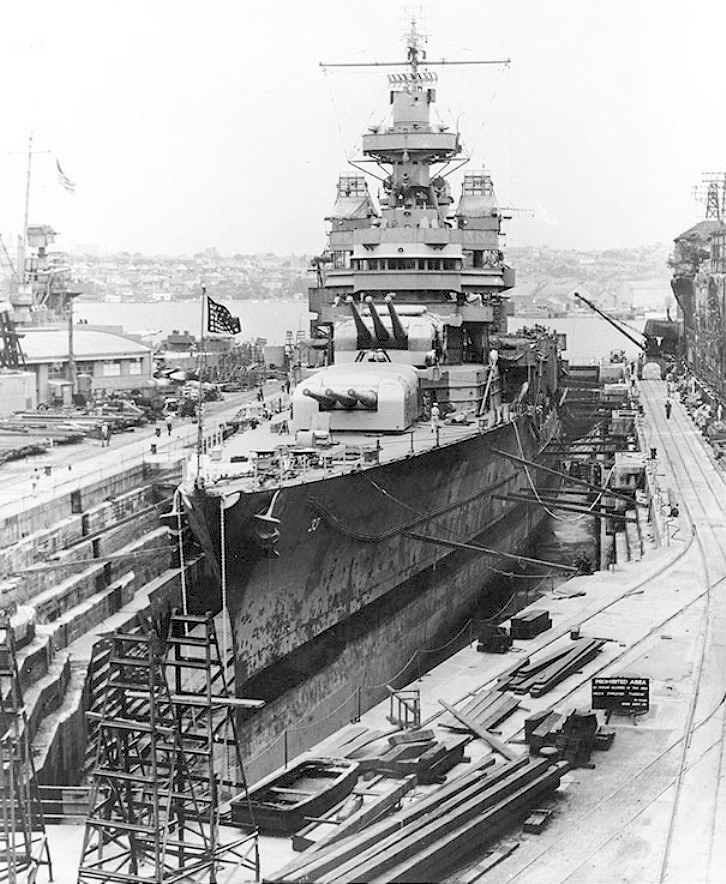 Naval Battle of Guadalcanal Portland_in_Sydney_1942Background
After their defeats on New Georgia and in the Battle of Vella Gulf, the Japanese had evacuated their garrisons in the central Solomons. A staging post had been established at Horaniu on the north tip of Vella Lavella for the evacuation barges. In October 1943, 600 soldiers remained, and a force of nine destroyers—Fumizuki, Matsukaze, Yūnagi, Akigumo, Isokaze, Kazegumo, Yugumo, Shigure, Samidare—was dispatched under Rear-Admiral Matsuji Ijuin to rescue them.
Battle
At 22:30, they spotted a U.S. force of three destroyers—Selfridge, Chevalier, and O'Bannon, commanded by Captain Frank R. Walker—approaching from Vella Gulf. A second division of three U.S. destroyers—Ralph Talbot, Taylor, and La Vallette—was also sailing up the west coast of Vella Lavella. Walker did not wait for his other three destroyers to come up but attacked immediately. Both sides launched torpedoes and opened fire at about 23:00.
Yugumo, first in the Japanese line, was hit several times, knocking out her steering, and she was finished off by a torpedo and sunk at about 23:10. However, one of her torpedoes hit Chevalier, detonating the forward magazine. O'Bannon then collided with the crippled Chevalier, and for some time the two ships were locked together. Selfridge attacked alone and was hit by a torpedo at 23:06 and disabled. All three ships were severely damaged, and reinforcements were still 15 minutes away. However, the rest of the Japanese turned away, having perhaps misidentified the three approaching destroyers as cruisers.
 Naval Battle of Guadalcanal NavalGuadalcanalWashingtonAftermath
Shigure and Samidare off Bougainville just hours before the battle.
Chevalier could not be saved and was sunk around 03:00. The Japanese completed their evacuation mission, ending the second phase of Operation Cartwheel with the Allied capture of the central Solomons after a three-month campaign that cost the Allies six ships; the Japanese lost 16.
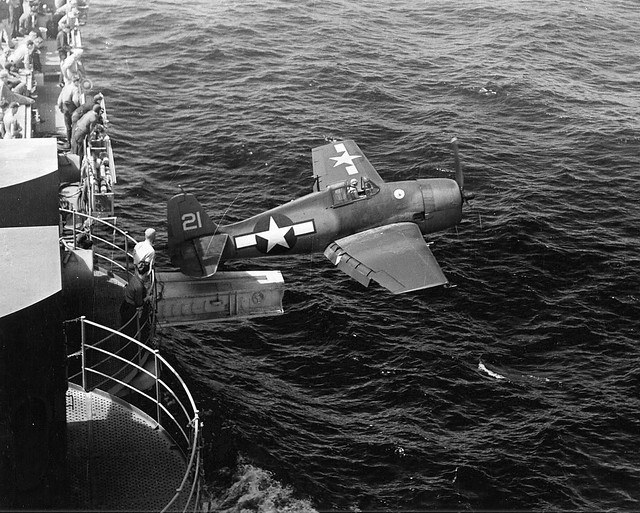 VF-2 Grumman F6F-3 Hellcat fighter catapult launch from 'Hornet'
From the USS Hornet (CV-12) hangar deck; five Essex class carriers were equipped with a hangar deck catapult, and the launching aircraft faced crosswinds as high as 35 knots when being shot out the side of the carrier. National Archives Photos from Navy History Center
 Naval Battle of Guadalcanal
About this USS Hornet:
Originally named Kearsarge, she was renamed Hornet in honor of the carrier Hornet lost during the Solomons Campaign in Oct 1942. Two days after this photo was taken, on 14 Feb 1944, she sailed from Norfolk, VA to join the Fast Carrier Task Force in the Marshalls. Her aircraft supported the invasion on New Guinea, bombarded Japanese bases in the Caroline Islands, and supported the landings on the Marianas Islands by striking Japanese bases on Iwo Jima and Chichi Jima on 15-16 Jun 1944, to prevent their reinforcing the Marianas. On 18 Jun, Hornet participated in the Battle of the Philippine Sea, aka "the Great Marianas Turkey Shoot". After raids on Japanese bases on Guam, Bonin, the Palau Islands, Okinawa, and Taiwan, she then supported the landings on Leyte, Philippines on 20 Oct 1944, and participated in the Battle off Samar by supporting the overwhelmed American fleet with air support. Near the end of the war, Hornet's aircraft raided the Japanese home islands and supported the landings on Iwo Jima and Okinawa.
As a carrier operating near Japan, Hornet was a prime target for whatever air power Japan had left. During the last 16 months of the war, she sustained 59 air attacks. But her pilots destroyed 1,410 Japanese aircraft and sank 1,269,710 tons of Japanese shipping.
After the war, Hornet participated in Operation Magic Carpet that brought American service men back to the United States. She returned to San Francisco on 9 Feb 1946, being decommissioned there in Jan 1947. She was recommissioned in 1951 for tension with Communist expansion in China and remained generally in the Pacific area on a wide array of missions, including the recovery of manned and unmanned spaceships of the Apollo program. She was decommissioned in 1970. Since 1998 she has been a museum ship at the former Alameda Naval Air Station in Alameda, California.
|
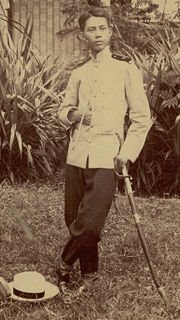














No comments:
Post a Comment